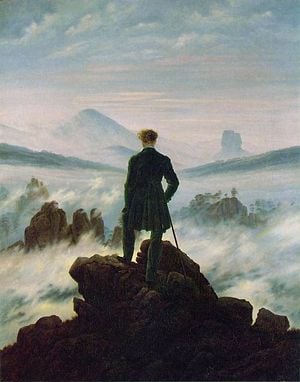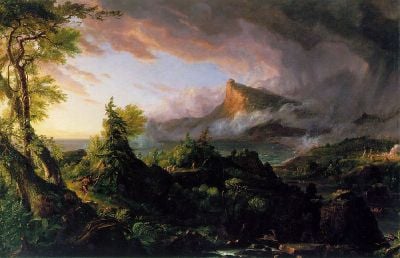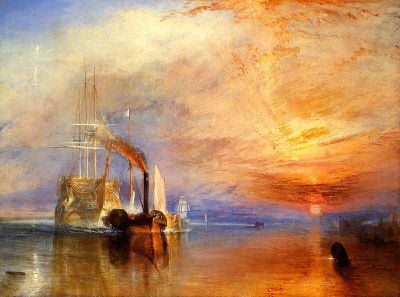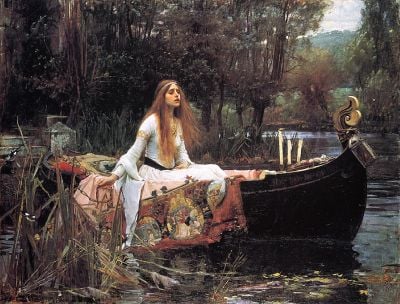Romanticism

Romanticism was an artistic and intellectual movement that ran from the late eighteenth century through the nineteenth century. It stressed strong emotion as a source of aesthetic experience, placing emphasis on such emotions as trepidation, horror, and the awe experienced in confronting the sublimity of nature. It elevated folk art, language, and custom, as well as arguing for an epistemology based on usage and custom.
Romanticism arose as a reaction against the excessive rationalism of the Enlightenment. It drew upon the French Revolution's rejection of aristocratic social and political norms. It was also influenced by the theory of evolution and uniformitarianism, which argued that "the past is the key to the present." Thus some Romantics looked back nostalgically to the sensibility of the Middle Ages and elements of art and narrative perceived to be from the medieval period. The name "romantic" itself comes from the term "romance" which is a prose or poetic heroic narrative originating in the medieval.
The ideals of the French Revolution influenced the Romantic movement in other ways. Romanticism elevated the achievements of what it perceived as misunderstood heroic individuals and artists that altered society, and legitimized the individual imagination as a critical authority which permitted freedom from classical notions of form in art.
The flaw in the Enlightenment mind, represented by the moral philosophy of Kant with its overemphasis on intellect (reason) and will, was its disregard of the faculty of emotion which is so central to human life. Romanticism was the inevitable reaction to Enlightenment Rationalism. The artistic and literary works of the Romantic movement have lasting appeal, because the human faculty of emotion runs stronger and deeper than the intellect or the will.
Characteristics
In a general sense, Romanticism refers to several distinct groups of artists, poets, writers, musicians, political, philosophical and social thinkers, and trends of the late eighteenth and early nineteenth centuries in Europe. This movement is typically characterized by its reaction against the Enlightenment; while the Enlightenment emphasized the primacy of reason, Romanticism emphasized imagination and strong emotion. Rather than an epistemology of deduction, the Romantics demonstrated elements of knowledge through intuition. A precise characterization and a specific description of Romanticism were objects of intellectual history and literary history for all of the twentieth century without the emergence of any great measure of consensus.
Arthur Lovejoy attempted to demonstrate the difficulty of this problem in his seminal article "On The Discrimination of Romanticisms" in his Essays in the History of Ideas (1948); some scholars see romanticism as completely continuous with the present, some see it as the inaugural moment of modernity, some see it as the beginning of a tradition of resistance to the Enlightenment, and still others date it firmly in the direct aftermath of the French Revolution. Perhaps the most instructive and succinct definition comes from French symbolist poet, Charles Baudelaire: "Romanticism is precisely situated neither in choice of subject nor exact truth, but in a way of feeling."
Some modernist writers argue that Romanticism represents an aspect of the Counter-Enlightenment, a negatively charged phrase used to label movements or ideas seen by them as counter to the rationality and objectivity inherent in the Enlightenment, and promoting emotionalism, superstition and instability.
Generally, Romanticism can be understood as a pursuit for the value of beauty on the part of humans because they have the faculty of emotion. Of course, humans also have two other faculties: Intellect and will, which pursue the values of truth and goodness, respectively. But when intellect (reason) is emphasized one-sidedly as in the Enlightenment in the eighteenth century, and when will is stressed very much as in the moral philosophy of Immanuel Kant around the end of the eighteenth century, human beings naturally react with their faculty of emotion as in Romanticism.
Visual art and literature
In visual art and literature, “Romanticism” typically refers to the late eighteenth century and the nineteenth Century. The Scottish poet James Macpherson influenced the early development of Romanticism with the international success of his Ossian cycle of poems published in 1762, inspiring both Johann Wolfgang von Goethe and the young Walter Scott.
An early German influence came from Goethe, whose 1774 novel The Sorrows of Young Werther had young men throughout Europe emulating its protagonist, a young artist with a very sensitive and passionate temperament. At that time Germany was a multitude of small separate states, and Goethe's works would have a seminal influence in developing a unifying sense of nationalism. Important writers of early German romanticism were Ludwig Tieck, Novalis (Heinrich von Ofterdingen, 1799) and Friedrich Hölderlin. Heidelberg later became a center of German romanticism, where writers and poets such as Clemens Brentano, Achim von Arnim, and Joseph von Eichendorff met regularly in literary circles.
Since the Romanticists opposed the Enlightenment, they often focused on emotions and dreams as opposed to rationalism. Other important motifs in German Romanticism are traveling, nature and ancient myths. Late German Romanticism (of, for example, E. T. A. Hoffmann's Der Sandmann—“The Sandman,” 1817; and Eichendorff's Das Marmorbild—“The Marble Statue,” 1819) was somewhat darker in its motifs and has some gothic elements.
Romanticism in British literature developed in a different form slightly later, mostly associated with the poets William Wordsworth and Samuel Taylor Coleridge, whose co-authored book Lyrical Ballads (1798) sought to reject Augustan poetry in favor of more direct speech derived from folk traditions. Both poets were also involved in Utopian social thought in the wake of the French Revolution. The poet and painter William Blake is the most extreme example of the Romantic sensibility in Britain, epitomized by his claim, “I must create a system or be enslaved by another man's.” Blake's artistic work is also strongly influenced by medieval illuminated books. The painters Joseph Mallord William Turner and John Constable are also generally associated with Romanticism.
Lord Byron, Percy Bysshe Shelley, Mary Shelley, and John Keats constitute another phase of Romanticism in Britain. The historian Thomas Carlyle and the Pre-Raphaelite Brotherhood represent the last phase of transformation into Victorian culture. William Butler Yeats, born in 1865, referred to his generation as "the last romantics."
In predominantly Roman Catholic countries, Romanticism was less pronounced than in Germany and Britain, and tended to develop later, after the rise of Napoleon. François-René de Chateaubriand is often called the "Father of French Romanticism."
In France, the movement is associated with the nineteenth century, particularly in the paintings of Théodore Géricault and Eugène Delacroix, the plays, poems and novels of Victor Hugo (such as Les Misérables and Ninety-Three), and the novels of Stendhal. The composer Hector Berlioz is also important.
In Russia, the principal exponent of Romanticism is Alexander Pushkin. Mikhail Lermontov attempted to analyze and bring to light the deepest reasons for the Romantic idea of metaphysical discontent with society and self, and was much influenced by Lord Byron. Pushkin's Eugene Onegin and Lermontov's Pechorin from A Hero of Our Time both were influenced by the "Byronic" pose, the boredom of the superior romantic hero. Both the poets would die in duels of honor. The poet Fyodor Tyutchev was also an important figure of the movement in Russia, and was heavily influenced by the German Romantics.
Romanticism played an essential role in the national awakening of many Central European peoples lacking their own national states, particularly in Poland, which had recently lost its independence to Russia when its army crushed the Polish Rebellion under the reactionary Nicholas I. Revival of ancient myths, customs and traditions by Romantic poets and painters helped to distinguish their indigenous cultures from those of the dominant nations (Russians, Germans, Austrians, Turks, etc.). Patriotism, nationalism, revolution and armed struggle for independence also became popular themes in the arts of this period. Arguably, the most distinguished Romantic poet of this part of Europe was Adam Mickiewicz, who developed an idea that Poland was the “Messiah of nations,” predestined to suffer just as Jesus had suffered to save all the people.[1]

In the United States, the romantic gothic makes an early appearance with Washington Irving's The Legend of Sleepy Hollow (1819), followed from 1823 onwards by the fresh Leatherstocking Tales of James Fenimore Cooper. They emphasized heroic simplicity and their fervent landscape descriptions of an already-exotic mythicized frontier peopled by "noble savages" was similar to the philosophical theory of Jean-Jacques Rousseau, like Uncas in Cooper's The Last of the Mohicans, for example. There also are picturesque elements in Washington Irving's essays and travel books.

Edgar Allan Poe's tales of the macabre and his balladic poetry were more influential in France than at home, but the romantic American novel is fully developed in Nathaniel Hawthorne's atmosphere and melodrama. Later Transcendentalist writers such as Henry David Thoreau and Ralph Waldo Emerson still show elements of its influence, as does the romantic realism of Walt Whitman. But by the 1880s, psychological and social realism was competing with romanticism. The poetry which Americans wrote and read was all romantic or heavily influenced by it until the rise of modernism in 1920s. This includes Poe and Hawthorne, as well as Henry Wadsworth Longfellow. The poetry of Emily Dickinson—nearly unread in her own time—and Herman Melville's novel Moby-Dick show the lingering influence of romantic themes, even as they evoked a more realistic and sometimes deeply psychological and philosophical view of the world. As elsewhere (England, Germany, France), American literary Romanticism had its counterpart in the visual arts, most especially in the exaltation of untamed America found in the paintings of the Hudson River School.
In the twentieth century, Russian-American writer Ayn Rand called herself a romantic, and thought she might be a bridge from the Romantic era to an eventual esthetic rebirth of the movement. She wrote a book called The Romantic Manifesto and called her own approach “Romantic realism.”
Music
Romanticism and music
In general, the term “Romanticism” applied to music has come to mean the period roughly from the 1820s until 1910. The contemporary application of “romantic” to music did not coincide with modern categories. In 1810, E.T.A. Hoffmann called Mozart, Haydn, and Beethoven the three "Romantic Composers," while Ludwig Spohr used the term "good Romantic style" to apply to parts of Beethoven's Fifth Symphony. By the early twentieth century, the sense that there had been a decisive break with the musical past led to the establishment of the nineteenth century as "The Romantic Era," and as such it is referred to in the standard encyclopedias of music.
However the twentieth century general use of the term “romanticism” amongst music writers and historians did not evolve in the same way as it did amongst literary and visual arts theorists, so that there exists a disjunction between the concept of romanticism in music and in the other arts. Literary and visual art theorists tend to consider romanticism in terms of the alienation of the artist and the value of art for art's sake, concepts only gradually creeping into musicology, where there is still considerable confusion between “music of Romanticism” and the less definable, (perhaps somewhat redundant) category of “music of the Romantic Era.” The traditional discussion of the music of Romanticism includes elements, such as the growing use of folk music, which are more directly related to nationalism and are only indirectly related to Romanticism.
Some aspects of Romanticism are already present in eighteenth-century music. The heightened contrasts and emotions of Sturm und Drang seem a precursor of the Gothic in literature, or the sanguinary elements of some of the operas of the period of the French Revolution. The libretti of Lorenzo da Ponte for Mozart, and the eloquent music the latter wrote for them, convey a new sense of individuality and freedom. In Beethoven, perhaps the first incarnation since the Renaissance of the artist as hero, the concept of the Romantic musician begins to reveal itself—the man who, after all, morally challenged the Emperor Napoleon himself by striking him out from the dedication of the Symphony no. 3, the Eroica Symphony. In Beethoven's Fidelio he creates the apotheosis of the “rescue operas” which were another feature of French musical culture during the revolutionary period, in order to hymn the freedom which underlay the thinking of all radical artists in the years of hope after the Congress of Vienna.
Beethoven's use of tonal architecture in such a way as to allow significant expansion of musical forms and structures was immediately recognized as bringing a new dimension to music. The later piano music and string quartets, especially, showed the way to a completely unexplored musical universe. The writer, critic (and composer) Hoffmann was able to write of the supremacy of instrumental music over vocal music in expressiveness, a concept which would previously have been regarded as absurd. Hoffmann himself, as a practitioner both of music and literature, encouraged the notion of music as 'programmatic' or telling a story, an idea which new audiences found attractive, however, irritating it was to some composers (for example, Felix Mendelssohn). New developments in instrumental technology in the early nineteenth century—iron frames for pianos, wound metal strings for string instruments—enabled louder dynamics, more varied tone colors, and the potential for sensational virtuosity. Such developments swelled the length of pieces, introduced programmatic titles, and created new genres such as the free standing overture or tone-poem, the piano fantasy, nocturne and rhapsody, and the virtuoso concerto, which became central to musical Romanticism. In opera a new Romantic atmosphere combining supernatural terror and melodramatic plot in a folkloric context was most successfully achieved by Carl Maria von Weber's Der Freischütz (1817, 1821). Enriched timbre and color marked the early orchestration of Hector Berlioz in France, and the grand operas of Giacomo Meyerbeer. Amongst the radical fringe of what became mockingly characterized (adopting Wagner's own words) as “artists of the future,” Liszt and Wagner each embodied the Romantic cult of the free, inspired, charismatic, perhaps ruthlessly unconventional individual artistic personality.
It is the period of 1815 to 1848, which must be regarded as the true age of Romanticism in music—the age of the last compositions of Beethoven (d. 1827) and Schubert (d. 1828), of the works of Schumann (d. 1856) and Chopin (d. 1849), of the early struggles of Berlioz and Richard Wagner, of the great virtuosi such as Paganini (d. 1840), and the young Franz Liszt and Sigismond Thalberg. Now that people are able to listen to the work of Mendelssohn (d. 1847) stripped of the Biedermeier reputation unfairly attached to it, he can also be placed in this more appropriate context. After this period, with Chopin and Paganini dead, Liszt retired from the concert platform at a minor German court, Wagner effectively in exile until he obtained royal patronage in Bavaria, and Berlioz still struggling with the bourgeois liberalism which all but smothered radical artistic endeavor in Europe, Romanticism in music was surely past its prime—giving way, rather, to the period of musical romantics.
Music after 1848
Romantic nationalism—the argument that each nation had a unique individual quality that would be expressed in laws, customs, language, logic, and the arts—found an increasing following after 1848. Some of these ideals, linked to liberal politics, had been exemplified in Beethoven's antipathy to Napoleon's adoption of the title of emperor, and can be traced through to the musical patriotism of Schumann, Verdi, and others. For these composers and their successors the nation itself became a new and worthy theme of music. Some composers sought to produce or take part in a school of music for their own nations, in parallel with the establishment of national literature. Many composers would take inspiration from the poetic nationalism present in their homeland. This is evident in the writings of Richard Wagner, especially after 1850, but can be clearly seen in Russia, where the Kuchka (handful) of nationalist composers gathered around Mily Balakirev, including Modest Mussorgsky, Alexander Borodin, and Nikolai Rimsky-Korsakov. These composers were concerned about the enormous influence of German music in Russia, and they largely resented the founding of the conservatoires in Moscow and Saint Petersburg by the brothers Nikolai and Anton Rubinstein, which they believed would be Trojan horses for German musical culture (however, Russian romantic music is today now closely identified with Anton's favorite pupil, Pyotr Ilyich Tchaikovsky).
This movement continued forward through into the twentieth century with composers such as Jean Sibelius, although nationalism found a new musical expression in study of folk-song which was to be a key element in the development of Béla Bartók, Ralph Vaughan Williams, and others.
Labels like “Late Romantic” and “Post-Romantic” are sometimes used to link disparate composers of various nationalities, such as Giacomo Puccini, Jean Sibelius, Richard Strauss, Samuel Barber and Ralph Vaughan Williams, all of whom lived into the middle of the twentieth century. The conscious “Modernisms” of the twentieth century all found roots in reactions to Romanticism, increasingly seen as not realistic enough, even not brutal enough, for a new technological age. Yet Arnold Schoenberg's later spare style had its roots in rich freely chromatic atonal music evolving from his late Romantic style works, for example the giant polychromatic orchestration of Gurrelieder; and Igor Stravinsky's originally controversial ballets for Sergei Diaghilev seem to us far less controversial today when we can understand their descent from Rimsky-Korsakov.
Nationalism
One of Romanticism's key ideas and most enduring legacies is the assertion of nationalism, which became a central theme of Romantic art and political philosophy. From the earliest parts of the movement, with their focus on development of national languages and folklore, and the importance of local customs and traditions, to the movements which would redraw the map of Europe and lead to calls for self-determination of nationalities.
Early Romantic nationalism was strongly inspired by Rousseau, and by the ideas of Johann Gottfried von Herder, who, in 1784, argued that geography formed the natural economy of a people and shaped their customs and society.
The nature of nationalism changed dramatically, however, after the French Revolution, with the rise of Napoleon, and the reactions in other nations. Napoleonic nationalism and republicanism were, at first, inspirational to movements in other nations: Self-determination and a consciousness of national unity were held to be two of the reasons why France was able to defeat other countries in battle. But as the French Republic became Napoleon's Empire, Napoleon became not the inspiration for nationalism, but the objection to it.
In Prussia, the development of spiritual renewal as a means to engage in the struggle against Napoleon was argued by, among others, Johann Gottlieb Fichte a disciple of Immanuel Kant. The word Volkstum, or nationality, was coined in German as part of this resistance to the now conquering emperor. Fichte expressed the unity of language and nation in his thirteenth address "To the German Nation" in 1806:
Those who speak the same language are joined to each other by a multitude of invisible bonds by nature herself, long before any human art begins; they understand each other and have the power of continuing to make themselves understood more and more clearly; they belong together and are by nature one and an inseparable whole. …Only when each people, left to itself, develops and forms itself in accordance with its own peculiar quality, and only when in every people each individual develops himself in accordance with that common quality, as well as in accordance with his own peculiar quality—then, and then only, does the manifestation of divinity appear in its true mirror as it ought to be.[2]
See also
Notes
- ↑ Dorota Zakrzewska, Alienation and Powerlessness: Adam Mickiewicz's "Ballady" and Chopin's Ballades Polish Music Journal 2:1-2 (1999). Retrieved April 11, 2022.
- ↑ Johann Gottlieb Fichte, Addresses to the German Nation (Cambridge University Press, 2009, ISBN 0521448735).
ReferencesISBN links support NWE through referral fees
- Abrams, Meyer H. The Mirror and the Lamp: Romantic Theory and the Critical Tradition. New York, NY: Oxford University Press, 1971. ISBN 0195014715
- Brion, Marcel. Art of the Romantic Era: Romanticism, Classicism, Realism. New York, NY: Henry Holt & Company, Inc., 1966. ISBN 0275420906
- Fichte, Johann Gottlieb. Addresses to the German Nation. Cambridge University Press, 2009. ISBN 0521448735
- Friedlaender, Walter. David to Delacroix. Nabu Press, 2011. ISBN 978-1175814777
- Novotny, Fritz. Painting and Sculpture in Europe, 1780-1880 New Haven, CT: Yale University Press, 1971. ISBN 0300053215
External links
All links retrieved December 15, 2022.
- The Romantic Poets
- Romantic Circles
- Romanticism English Department, Brooklyn College.
- Romanticism The Metropolitan Museum of Art.
Credits
New World Encyclopedia writers and editors rewrote and completed the Wikipedia article in accordance with New World Encyclopedia standards. This article abides by terms of the Creative Commons CC-by-sa 3.0 License (CC-by-sa), which may be used and disseminated with proper attribution. Credit is due under the terms of this license that can reference both the New World Encyclopedia contributors and the selfless volunteer contributors of the Wikimedia Foundation. To cite this article click here for a list of acceptable citing formats.The history of earlier contributions by wikipedians is accessible to researchers here:
The history of this article since it was imported to New World Encyclopedia:
Note: Some restrictions may apply to use of individual images which are separately licensed.

